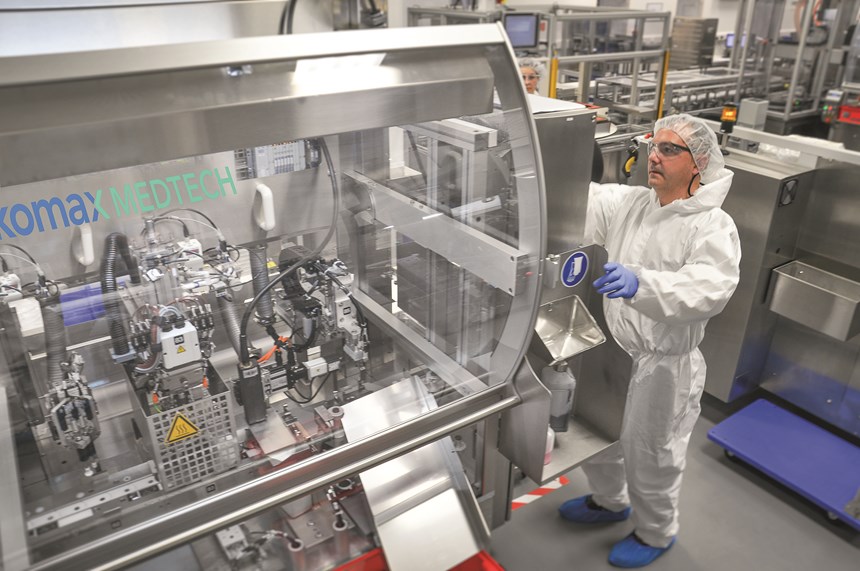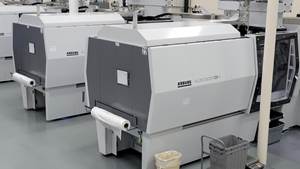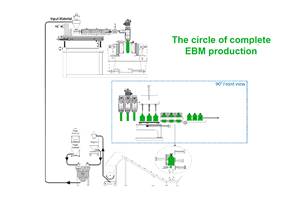The competitive and regulatory demands on medical-device OEMs require them to work with injection molders that can bring the right environment, equipment, engineering materials, and employees to the manufacture of their designs. These “Four E’s” encompass important evaluative criteria by which medical-device manufacturers identify and measure with whom they partner among molders and other plastics processors. The criteria under each are defined as follows:
- Environment: Includes cleanrooms and non-cleanrooms, and quality and regulatory requirements such as cGMP, ISO 13485, ISO 9001, and lot traceability.
- Equipment: Covers injection molding machinery, molds, robotics and assembly automation.
- Engineering Materials: Encompasses non-commodity plastics with challenging process requirements. Includes supply lot controls, USP Class VI, BSE/TSE and 10993 compliance.
- Employees: Includes highly-skilled people who work with technically advanced molds, equipment and processes supporting complex mold and assembly validations.
The Four E’s represent more than evaluative criteria for medical molders. In many ways, they define higher standards for performance that set these molders apart and qualify them for the rigorous demands of medical-device manufacture.
ENVIRONMENT
Like the industry they serve, medical molders operate in a highly regulated, quality-intensive environment that often involves manufacturing products in cleanrooms that require special air-filtration systems. The decision to use a cleanroom depends on the level of air cleanliness—a function of airborne particle sizes and quantities—required during manufacturing.
Most, but not all, Class II medical devices are molded or assembled in ISO Class 8 cleanrooms.
To ensure air cleanliness, cleanrooms rely on HEPA filters installed in the ceiling, where air enters the room through the ceiling and sweeps down to the base of the walls to exhaust ducts near the floor. The air flow is laminar, top to bottom, and keeps particles from floating in the air, causing contamination.
There are different classifications of cleanrooms, each of which indicates the allowable size and amount of particulate matter in a cubic volume of air. A cleanroom’s classification also determines the frequency of complete air changes. In a typical 25,000 ft2 ISO 8 cleanroom, the entire room volume of air is changed more than 20 times/hr. Of course, HEPA filters need to be replaced and cleanrooms require periodic cleaning. Medical molders operate according to strictly documented procedures that describe these and other requirements.
For instance, employees must follow specific procedures for gowning. Donning is done from top to bottom, starting with a hair/beard net and followed by a coat, pants and shoe covers. A bench separates “clean” and “dirty” sides so that an employee’s shoes won’t contaminate the floor. Jewelry must be covered or removed completely. Hearing protection, safety glasses and gloves are also mandatory.
Most molding cleanrooms are certified to ISO 8 standards. Nypro’s molding cleanrooms are all ISO 8 certified, while its cleanrooms for assembly are ISO 8 or ISO 7—a more stringent standard. If cleanroom manufacturing is required for a project, the customer’s quality specs will indicate the ISO level. In medical molding, it’s especially critical to follow written documentation and procedures.
When a medical-device designer is unsure whether a molded product requires cleanroom manufacturing, the U.S. Food and Drug Administration’s (FDA) device classification can be helpful.
For example, Class I medical devices may not require cleanroom molding because they carry the lowest level of risk and must comply with the lowest amount of regulatory control. Examples of these simple devices include elastic bandages, dental floss, floss boxes and toothbrushes. Class II medical devices have medium complexity but pose a higher risk. Therefore, they carry more stringent regulatory controls to ensure they are safe and effective.
Most, but not all, Class II medical devices are molded or assembled in ISO Class 8 cleanrooms. Among the medical parts molded in cleanrooms are asthma inhalers and auto-injector pens. Class II devices that do not require cleanroom manufacture include condoms and pregnancy testing kits.
Class III medical devices are the most complex, carry the highest risk and, consequently, impose the most stringent regulatory controls. Examples include implantable pacemakers, continuous glucose monitors, and other implants, all of which are usually molded and assembled in cleanrooms to minimize the potential for contamination from airborne particulate.
Together, the costs and procedures required to maintain these highly regulated and quality-intensive environments can pose a major barrier to entry to medical molding and set the practice apart from conventional industrial molders. Establishing a quality-management system (QMS) to meet FDA requirements for 21 CFR 820 compliance, cGMPs, and ISO 13485 certification is expensive. It may also require hiring additional quality personnel.
Maintaining certifications and compliance can be challenging as well. There are regular audits by ISO registrars, continuous audits by customers, and periodic audits by the FDA. Quality documentation begins at incoming inspection when a certificate of analysis (COA) for materials is captured as part of the device history file (DHF). Batch records must be kept for several years and must provide complete traceability.
Questions about Medical Molding? Visit the Medical Zone.
Medical molders also need statistical process-control (SPC) charting and the validated inspection of critical and process-sensitive dimensions. All molds and assembly automation must be validated and undergo a rigorous installation qualification, operational qualification, and performance qualification (IQ/OQ/PQ) process. Fully documented reports include first-article inspection (FAI) and process-capability results that require customer approval for production readiness.
EQUIPMENT
Not surprisingly, medical-molding equipment must undergo strict installation qualification procedures. Confirming the correct setup is essential for compliance, quality, safety and cost control. Most injection molding machines are housed entirely inside ISO 8 cleanrooms. Medical molders must also identify and document their equipment to support daily process audits.
Most of Nypro’s presses are equipped with robots that automatically remove finished parts to ensure they remain clean and undamaged. The machine-mounted robots also provide mold protection by confirming part removal and preventing the mold from closing on parts.
Molding machines can be either electric or hydraulic. Electric molding machines use approximately 40-50% of the electricity of hydraulic equipment, which explains their favor for lowering manufacturing costs. However, hydraulic equipment is still a better fit for some larger-tonnage, thin-wall packaging applications.
For both electric and hydraulic equipment, however, medical molding machines must be closed-loop systems with precision injection and clamp movement. Today, many medical devices incorporate small, intricate parts with complex, multi-functional geometries. This requires injection molds with complex actions or mold movements.
Medical molders need controls to avoid cross-contamination between jobs, with rigorous line-clearance procedures and frequent process audits.
Molds used in medical molding can have as many as 128 cavities. They include hot- or cold-runner, single- or two-shot mold designs. Because mold validation is time-consuming and expensive, molds must be built to high quality standards that will achieve millions of cycles. For best results, they are made of high-quality steels such as 420 stainless steels, H13 or S7.
Some medical applications preclude the use of nickel-plated components. Other applications don’t allow beryllium copper components that make direct contact with plastic parts. Microtiter plates used in blood diagnostics are a good example, as beryllium copper may interfere with the binding of antigens inside the plastic wells and affect diagnostic results. Another example is a molded surface that contacts blood flow or a drug, formed by a mold component that could transfer small particles of beryllium copper.
Material handling also poses extremely important considerations for medical molders. Contamination from using the wrong material is costly. It’s an even bigger problem if the molder doesn't catch the mistake. Medical molders need controls to avoid cross contamination between jobs, with rigorous line-clearance procedures and frequent process audits.
Typically, material handling is performed outside of the cleanroom. Material is vacuum transferred from the gaylord into a dryer, if required, and then vacuum transferred into the molding machine hopper.
Proper material handling also helps to prevent black-speck contamination. Often, black-speck allowance limits are specified on the plastic part quality plan and the customer’s quality specifications. Most, but not all, medical products require 100% virgin material. Regrind is not allowed when there is risk of contamination or the loss of mechanical properties. Avoiding regrind can also minimize the presence of black specks.
ENGINEERING MATERIALS
Many medical molding applications use highly engineered materials to improve performance in medical devices. These materials may contain special additives like PTFE (a fluoropolymer) or silicone for a low coefficient of friction and low-glide-force performance.
Compared with commodity materials, engineering materials are harder to process and have narrower processing windows. Validation requires documenting the material melt-flow index (MFI) and ensuring that this value is within a specified range.
Nypro requires material certificates of analysis (COA) or conformance (COC) with each lot of material to indicate both melt-flow index and filler content. Certifications for each lot are reviewed at incoming inspection and before use. Lot numbers become part of the DHF and provide traceability for the material used in molded parts. Traceability resolution is available to the box level.
In engineering materials, additives such as oils and fillers are controlled by percentage. To ensure consistent processing and molded part performance, a medical molder must specify and document non-substitution agreements. Engineering materials must also comply with restrictions or regulations such as USP Class VI (U.S. Pharmacopeia biocompatibility), ISO 10993 biocompatibility, and BSE/TSE (bovine-free compliance).
When high-volume colored materials are used, medical molders like Nypro buy precolored or color-compounded materials. Low-volume colored materials are mixed at Nypro from color concentrates. Materials with fillers are always precompounded at the material supplier.
EMPLOYEES
Last but certainly not least, highly skilled employees are one of the “Four E’s” that medical molders must have in order to succeed. Managers, engineers, technicians, inspectors and operators must know and understand current Good Manufacturing Practices (cGMP) for both medical molding and assembly, and work with care and diligence to ensure high levels of quality and compliance.
The complexity of medical molds and extensive validations demand high skill levels. Generally, the salaries of medical molding employees are higher than for conventional/industrial molders.
Molders looking to take on medical-device manufacturing must be cognizant of the intrinsic challenges and costs imposed by this industry. Without investing in the proper environment, equipment, engineering-material processing knowledge, and highly skilled employees, device manufacturers may find a particular molder ill equipped to meet their needs. These key fundamental elements of medical molding can make the difference between success and failure in medical-device manufacturing and being awarded new opportunities.
ABOUT THE AUTHOR: Stephen Costa is senior director of plastics engineering & technology for Nypro, a Jabil Company, based in Clinton, Mass. In this role, he oversees central quoting for plastic molded parts, assembly, molds, and assembly automation for its healthcare business. He also provides technical support to Nypro sites, and contributes to new technology development and adoption efforts related to plastics processing and equipment. Previously, Costa held several roles at Nypro, serving as global program director for Healthcare, director of engineering, senior program manager and senior tooling engineer. Costa’s expertise includes single- and two-shot tooling, injection molding, automation, and program and engineering management. Contact: (978) 365-9721; nypro.com.
Related Content
Consistent Shots for Consistent Shots
An integral supplier in the effort to fast-track COVID-19 vaccine deployment, Retractable Technologies turned to Arburg and its PressurePilot technology to help deliver more than 500 million syringes during the pandemic.
Read MoreLatest Data on Bottled Water Shows Continued Strong Growth
Bottled water’s volume surpassed soft drinks for the first time in 2016 and has done so every year since.
Read MoreGet Color Changes Right In Extrusion Blow Molding
Follow these best practices to minimize loss of time, material and labor during color changes in molding containers from bottles to jerrycans. The authors explore what this means for each step of the process, from raw-material infeed to handling and reprocessing tails and trim.
Read MoreMultilayer Solutions to Challenges in Blow Molding with PCR
For extrusion blow molders, challenges of price and availability of postconsumer recycled resins can be addressed with a variety of multilayer technologies, which also offer solutions to issues with color, processability, mechanical properties and chemical migration in PCR materials.
Read MoreRead Next
People 4.0 – How to Get Buy-In from Your Staff for Industry 4.0 Systems
Implementing a production monitoring system as the foundation of a ‘smart factory’ is about integrating people with new technology as much as it is about integrating machines and computers. Here are tips from a company that has gone through the process.
Read MoreSee Recyclers Close the Loop on Trade Show Production Scrap at NPE2024
A collaboration between show organizer PLASTICS, recycler CPR and size reduction experts WEIMA and Conair recovered and recycled all production scrap at NPE2024.
Read MoreFor PLASTICS' CEO Seaholm, NPE to Shine Light on Sustainability Successes
With advocacy, communication and sustainability as three main pillars, Seaholm leads a trade association to NPE that ‘is more active today than we have ever been.’
Read More


















